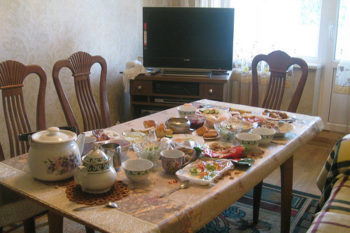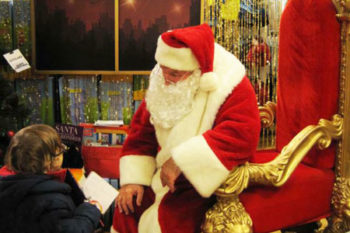The ukukus in our party wore long, dark, shaggy costumes; black knitted masks pushed back on their heads. Every once in a while they would let out a long wail on a horn, a few sharp blasts on a whistle, or twist their whips in their hands. But otherwise they were like us – clad in thermals, hiking boots peeking out beneath costumes, talking about partners and kids back home.
 Until we had arrived at the yearly religious festival of Qoyllur Rit’i, until we had made the 8 km pilgrimage to this remote Andean valley at 4,700 metres, my partner Gabriel had not even known that his friend John was one of the ukukus. And this is what struck me most about this celebration – its sheer earthiness and humanity. The ukukus, representing half-men half-bears, wield a considerable amount of power and responsibility but unlike the untouchable, elitist tinge of the Catholicism I grew up with, these dancers are men of their communities, jokers, tricksters, men you share a beer with, men who aren’t defined by the role they play here.
Until we had arrived at the yearly religious festival of Qoyllur Rit’i, until we had made the 8 km pilgrimage to this remote Andean valley at 4,700 metres, my partner Gabriel had not even known that his friend John was one of the ukukus. And this is what struck me most about this celebration – its sheer earthiness and humanity. The ukukus, representing half-men half-bears, wield a considerable amount of power and responsibility but unlike the untouchable, elitist tinge of the Catholicism I grew up with, these dancers are men of their communities, jokers, tricksters, men you share a beer with, men who aren’t defined by the role they play here.
And so we passed around a joint, stamping feet to keep warm in our campsite looking down over a shallow mountain basin filled with tents and the beating of drums. The sun had set and the festival was in full swing. It is predominately attended by devotees from rural Andean communities, naciones, who arrive with their own delegates of ritual dancers and musicians, usually including one or two ukukus. Each nación carries an icon of Christ, to pass the festival within the mountain church, in order to be revitalised in the presence of the Señor de Qoyllur Rit’i (Christ of the Snow Star) before returning once more to the community. Whole families make the pilgrimage: grandparents, mothers with babies wrapped in colourful blankets and tied to their backs, teen couples, little Andean kids with that peculiar maturity they seem to have even in infancy. They came and bedded down under sheets of blue plastic or in tents, fires blazing.
And they danced, and danced. The drums beat all night long, and we wandered down to the immediate surrounds of the church, fighting our way through the thronging crowds, watching girls twirling in colourful skirts, ukukus lashing at each other with their whips in ritual battles, qolla dancers in their elegant but energetic dances, ch’unchus in their feathered head dresses. Each type of dance, and dancer, holds a great deal of ritual significance, and, except for the ukukus, tend to fall into the categories of “Indian” or “outsider”.
The ukukus stand alone. Normally young, unmarried men, they are considered to be the only ones strong enough, in body and spirit, to withstand the condenados, the spirits of those who have committed unforgivable sins and wander the glacier above the Sinak’ara sanctuary, where we were gathered, seeking forgiveness and looking longingly on a sacred place they cannot enter.
“And then there’s us, ukukus that aren’t that ‘ukuku’”
We had returned to the campsite, and John was explaining the hierarchy within the ukukus. There are three bodies – those from Paucartambo, Quispicanchis and Canchis. The structure is rigid, with the seniors directing junior members about their duties during the festival. They were meant to maintain order, direct the flow of people, enforce the ban on drinking and ensure that hats were off during processions and mass. At the same time they kept up a steady barrage of jokes, clowning it up, speaking in high-pitched voices; keeping order while subverting it. This role of the trickster is vital in many indigenous American religious rites – one must laugh to truly know the sacred.
Others, like John, came mainly to dance, and did not share the other duties of their companions.
Later that night John and most of the other ukukus present left, climbing the glacier by the light of the moon, to pass the night there. I never was privy to what, exactly, went on in that select gathering, but John’s bottle of the hallucinogenic San Pedro was considerably lighter when he rejoined us the next day. In years gone by, the ukukus would carve off blocks of ice, to carry home to their villages, where it would bless the harvest and bring abundance and health to the community. These days, the decline of the glacier in the face of global warming is so pronounced that this custom has ceased.
And so we sat, preferring the chilly solitude of the campsite, listening to the great cacophony of musicians playing their own tunes with their own communities from all sides, watching the pulsing of the crowd below. I had arrived with Gabriel and his friends, Chango and Caneto. All Lima boys; non-Quechua speaking, 30-something, club-hopping, beer-swilling, Peruvian lads. A passing Indian woman, as we stopped to rest on the trek, had fondly referred to Gabriel as gringuito (little gringo – blondie – despite his dark hair and, to me, obvious Peruvian looks). They were not embedded in the festival like those who came from the local communities, and we sat on high and looked down, tourists. And yet they came. They came to pass a freezing cold night in tents at the foot of a glacier, not to some alcohol-driven frenetic dance party, but to this colourful and ritualised indigenous Catholic celebration.
Qoyllur Rit’i is, Chango told me, the only indigenous religious celebration in the Americas that is actually growing in attendance each year. Set so high above the world, it seemed, to my unfamiliar and foreign eyes, a celebration more pure and yet more approachable than any of the masses of my youth. I still remain, to a great extent, an outsider here, and yet I don’t sense the same cynicism that is present at home in Australia when it comes to matters of religion. A pago a la tierra in the building we hope to start a new hostel in was considered necessary by all of our friends, and when we slipped away from the group during Qoyllur Rit’i to bury the offering prepared for us by shaman who performed our pago, it was a perfectly natural thing to do.
Belief here feels more organic, more natural. Religion stripped of its purple robes and heavy incense, and a deep thread in the day-to-day life of many.
All photos belong to Camden.
Read more:
Feijoda in Brazil
Quebrada de humahuaca and Argentina’s nine day festival
Romanian traditions full of colour and energy







Very interesting post. I like how the Quechuas (and other ethnic groups in Peru and Bolivia) kept their traditions alive after the Spaniards colonized them and forced them to convert to Catholicism.